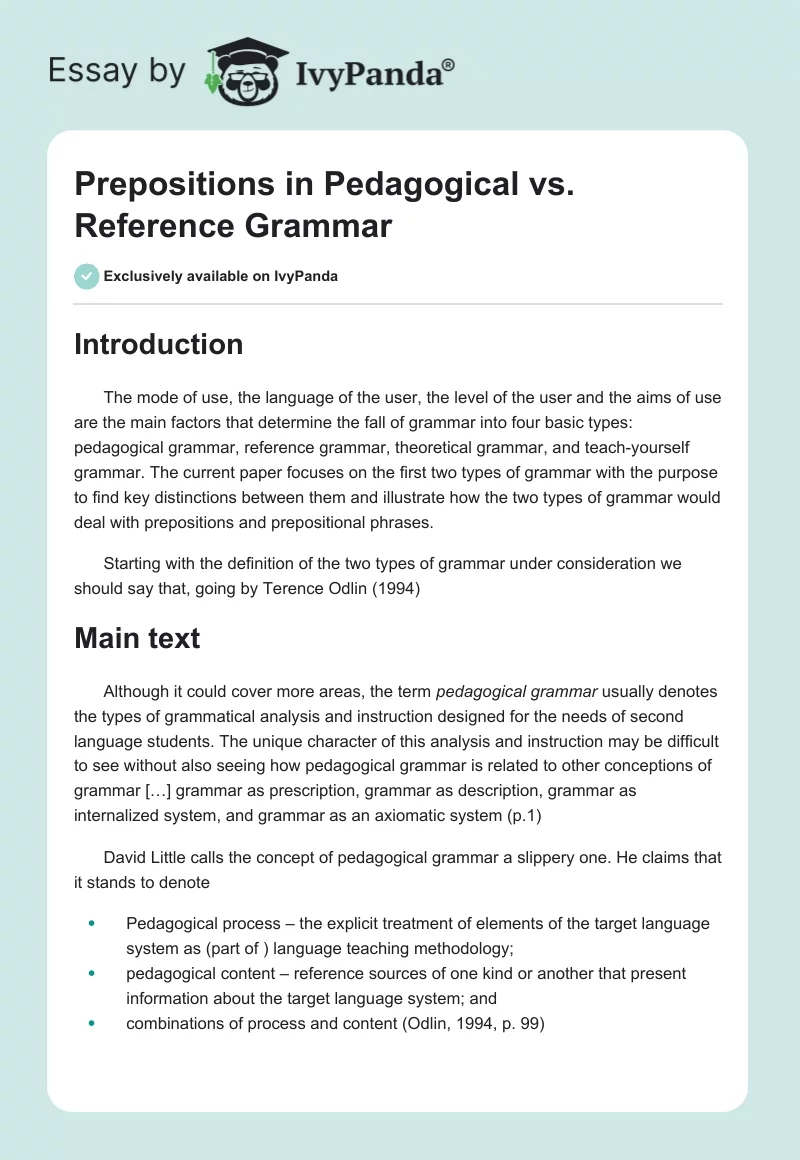Introduction
The mode of use, the language of the user, the level of the user and the aims of use are the main factors that determine the fall of grammar into four basic types: pedagogical grammar, reference grammar, theoretical grammar, and teach-yourself grammar. The current paper focuses on the first two types of grammar with the purpose to find key distinctions between them and illustrate how the two types of grammar would deal with prepositions and prepositional phrases.
Starting with the definition of the two types of grammar under consideration we should say that, going by Terence Odlin (1994)
Main text
Although it could cover more areas, the term pedagogical grammar usually denotes the types of grammatical analysis and instruction designed for the needs of second language students. The unique character of this analysis and instruction may be difficult to see without also seeing how pedagogical grammar is related to other conceptions of grammar […] grammar as prescription, grammar as description, grammar as internalized system, and grammar as an axiomatic system (p.1)
David Little calls the concept of pedagogical grammar a slippery one. He claims that it stands to denote
- Pedagogical process – the explicit treatment of elements of the target language system as (part of ) language teaching methodology;
- pedagogical content – reference sources of one kind or another that present information about the target language system; and
- combinations of process and content (Odlin, 1994, p. 99)
As far as the definition of the reference grammar is concerned The Glossary of Linguistic Terms edited by Eugene E. Loos defines it as “a prose-like description of the major grammatical constructions in a language, illustrated with examples.” (LinguaLinksLibrary, 2004)
Depending on the organization and the intended user’s reference grammar is divided into two types which are as follows.
Intended Users:
- Native speakers who want to understand their mother language better;
- Linguists who strive for information on the language that they use for comparative purposes.
Organization:
- Based on the forms that the readers make use of, but do not realize their significance to the grammar as a whole.
- Based on a universal outline form that helps the reader to make comparisons between the language under analysis and other languages.
Examples to illustrate this distinction are the sections of the definite and indefinite articles in the English language. In the first type of the reference grammar for English speakers there might be sections on the and a, in the second ones the and a may be treated in a section on ‘identifiability’ (LinguaLinksLibrary, 2004)
Comparison between the two types of grammar under consideration can be done according to the following principles:
- Purpose of use – a reference grammar serves as a reference tool when seeking specific details of the language, the aim of a pedagogical grammar is to teach students how to use a language;
- Organization – a reference grammar is organized according to universal structural categories, whereas organization of a pedagogical grammar is based on the principles of usefulness and ease of learning;
- Composition – chapters that a reference grammar consists of are longer than a pedagogical grammar has, the latter is characterized by short and brief grammatical explanations; a reference grammar chapters provide an explanation and one or several examples of every issue mentioned, a pedagogical grammar focuses on exercises that encourage the reader to practice and internalize the material learned;
- Target audience – a reference grammar is intended for those who see language as a universal phenomenon and want to know how this or that particular language correlates with the universal understanding of human language, a pedagogical grammar has a broader target audience – it is designed for everyone who is interested in learning a language.
Below follows the demonstration of how prepositions and prepositional phrases may be treated through grammatical and pedagogical perspectives.
Grammatically, there exists the following classification of prepositions:
- Simple – at, through, from, without;
- Compound – into, onto;
- Complex – as well as, according to, in favor of.
Prepositions do not stand alone, they need a complement:
- Noun, pronoun – at dawn, after you;
- Other parts of speech – by then, in short;
- Followed by –ing clause – Do not be ashamed of asking questions, this will enlarge your knowledge significantly; followed by wh- clause – For what we are about to meet is to exchange our knowledge.
Prepositions generally introduce prepositional phrases that look like: preposition + optional modifiers + noun, pronoun or gerund: at home, according to us, in the overcrowded bus.
Some prepositions may also function as subordinate conjunctions: after, as, before, since and until.
Pedagogical grammar will focus on the following characteristic of prepositions.
Meaning:
- Space and time – at;
- Cause and purpose – for;
- Agent and instrument – by, with;
- The versatile of.
Conclusion
If reference grammar focuses on more theoretical basis of the problem of prepositions and prepositional phrases, pedagogical grammar will suggest more exercises to practice the knowledge acquired.
Thus, we analyzed the difference between reference grammar and pedagogical grammar. The distinction is obvious if various principles are applied. Some examples of how two types of grammar treat prepositions and prepositional phrases were given. We are inclined to believe that both types of grammar along with those that this paper did not touch upon are equally important for students and teachers who deal with languages.
References
LinguaLinksLibrary. (2004). What is a reference grammar? Web.
Odlin, T. (1994). Perspectives on pedagogical grammar (Cambridge applied linguistics). Cambridge University Press.


